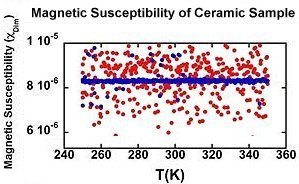
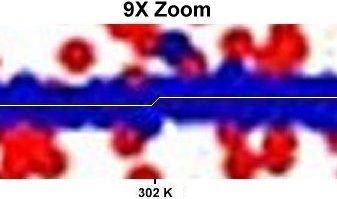


In December of 2011 Superconductors.ORG announced the discovery of the first true room-temperature superconductor - a senary oxycuprate with a transition temperature near 28.5 Celsius. Shortly after that Dr. Thom Mason, Director of Oak Ridge National Laboratory, viewed the data graphs of this discovery online and called them "tantalizing hints" of room-temperature superconductivity. Now O.R.N.L. SQUID tests have confirmed a diamagnetic transition is occuring at 28.5C.
Samples of the compound (Tl5Pb2)Ba2Mg2Cu9O17+ were delivered to Oak Ridge Labs on December 18, 2013, and tests were performed using a commercial SQUID magnetometer. Magnetization tests ranged from 250K to 350K with two different test criteria. Magnetic susceptibility was first measured with an applied magnetic field of 20 Gauss (red dots). This produced considerable scattering of the data points. Then another test was done with a higher applied magnetic field of 1 Tesla (blue dots). This produced a nearly straight line with much less scatter (see plot upper left). Readings were taken every 0.5K and the bulk material characterized as a "weak paramagnet" overall. However within the blue line representing the 1 Tesla data points was a visible negative shift near 302K, indicating a small diamagnetic component at 28.5 Celsius (see plot at upper right).
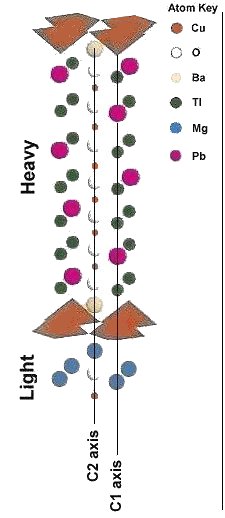
|
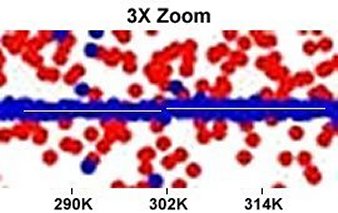 This diamagnetic shift, representing the Meissner transition, was not noticed the day of the tests, due to its small amplitude within a row of large dots. However, when the plot was later loaded into a graphics program and a thin line drawn down the middle of the dots, it became apparent (see above).
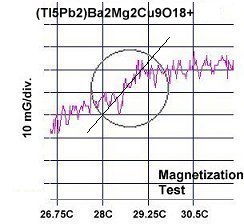
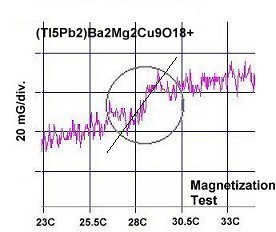
|
The original 2011 magnetization tests are shown above right for comparison. The Meissner transition in the plots represents about 10 milli-Gauss with a -10db noise floor. The original test pellet weighed about 1 gram. However, the O.R.N.L. sample was only 38.6 mg, producing a much weaker signal.
Meanwhile, resistance tests of this material at O.R.N.L. were inconclusive. The reason for this appears to be the lack of resolution in the O.R.N.L. test equipment. They report a source current of 100ua was applied across a sample with a bulk resistance of 200 ohms. This will produce less than 20mv of signal across the secondary of a 4-point probe. And, with the volume fraction being less than 1%, resolution below 200uv would be necessary to see a resistance change. The ORNL resistance plot only had a resolution of 400uv - equivalent to one pixel.
RE-PUBLICATION NOTICE: Elsevier Publishing, dba Elsevier Science, as well as Morris Communications, both print and broadcast divisions, are specifically prohibited from re-publishing any part of this news story.
E. Joe Eck
Provisional Patent US61/630,114
and subsequent patents pending
© 2011 - 2013 Superconductors.ORG
All rights reserved.
 BACK to "News" page at Superconductors.ORG
BACK to "News" page at Superconductors.ORG